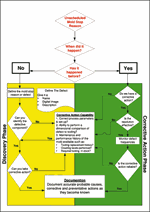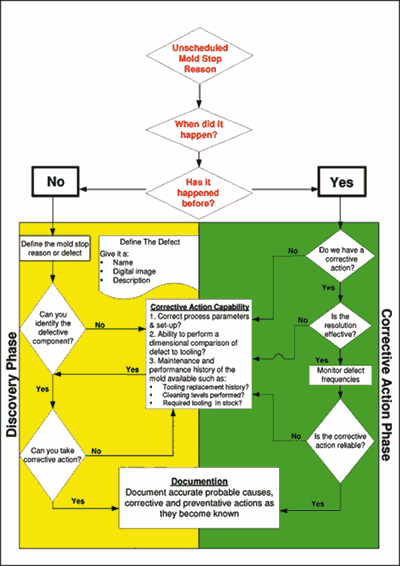Maintenance Supervisors: What You Should Know
To better understand what a toolroom supervisor needs to improve mold performance and maintenance efficiency, we need to further understand their challenges and job responsibilities.
Heading to work on a Monday morning I flashed back to last week’s mold breakdowns, grateful that my cell phone remained silent over the weekend. That does not mean everything ran okay; it just means that whatever broke down could apparently wait until today, to be enthusiastically discussed during the morning production meeting—when the real games begin.
Those in charge of keeping molds reliable and production-ready normally start their day in the same manner—wondering what broke down since they last walked out the door—and hoping they have the resources to get it going again.
The reason is because, the pace, stress level and work hours of a mold maintenance supervisor will be determined by what broke down, repair capability and how long it will take to get it up and running again. This is what firefighting is all about. Breakdowns dictate most shop maintenance schedules, leaving too few hours to schedule PMs, which allow more proactive tasks. This type work always seems to be a matter of “fitting it in”.
The last article discussed what type of PAR data (Performance and Repair) should be collected by the process tech-nicians who set, start and run molds and how they should use it within their job function. The next two articles will discuss a toolroom supervisor’s job function and what data he needs and how to use it to reduce breakdowns while performing his job more accurately and efficiently in a data-driven versus firefighting environment.
Getting to the Point
A main factor to increasing mold performance and maintenance efficiency lies in our ability to quickly and accurately decipher breakdown issues. Most breakdowns are repetitive, but the frequency and specific events that surround a breakdown typically goes unnoticed until it occurs again, leaving someone scratching their heads wondering “Didn’t this just happen?” and then “What did we do?” But once up and running, focus shifts again to the newest issue, so when a repeating-offender mold lands on a repair tech’s bench, he is concerned only with today’s issues with the mold—and not a potential correlation of problems from past runs.
A smaller percentage of breakdowns—or unscheduled mold stops—occasionally pertain to mold assembly events like the wrong tooling being installed in a mold or internal water leaks or missing tooling. As one who occasionally audits maintenance records in different companies, I see these type of mental mistakes occurring more often than anyone wants to admit to, that is why it is important to be able to first categorize issues, then count frequencies and costs of all breakdowns, so as to accurately prioritize where your problems really lie (see Chart).
| Mold Stop Reason |
Stop Count | Labor Hours | Labor Cost | Tooling Cost | Total Cost |
| X-External Oil Leak | 9 | 139.00 | $6,950.00 | $7,189.20 | $14,139.20 |
| X-Internal Water Leak | 24 | 148.25 | $7,412.50 | $2,810.00 | $10,222.50 |
| X-Galled Tooling | 16 | 73.00 | $3,650.00 | $3,603.75 | $7,253.75 |
| X-Mold Set Issues | 4 | 4.00 | $200.00 | $5,815.00 | $6,015.00 |
| X-Incorrect Mold Assembly | 13 | 44.00 | $2,200.00 | $3,750.00 | $5,950.00 |
| X-Flashed Mold | 11 | 93.75 | $4,687.50 | $455.38 | $5,142.88 |
| X-External Water Leak | 4 | 82.50 | $4,125.00 | $0.00 | $4,125.00 |
| X-Flashed Manifold | 2 | 59.75 | $2,987.50 | $0.00 | $2,987.50 |
| X-Residue Leaching Out | 9 | 37.25 | $1,862.50 | $0.00 | $1,862.50 |
| X-Scuffed Tooling | 1 | 14.00 | $700.00 | $0.00 | $700.00 |
| X-Incorrect Tooling Configuration | 1 | 5.00 | $250.00 | $0.00 | $250.00 |
| X-Excess Grease | 2 | 4.00 | $200.00 | $0.00 | $200.00 |
| Total | 96 | 704.50 | $35,225.00 | $23,623.33 | $58,848.33 |
| Demonstrates a year’s worth of mental mistakes for one company that were ultimately investigated and corrective measures (training) taken. Seventy-five percent of these were eliminated for the following year. Chart courtesy of MoldTrax. | |||||
But the majority of unscheduled mold stops are repetitive, mechanical problems whose root causes are either hidden in ambiguous work order terminology—or simply fade away—once running again and the heat is off.
So it is no surprise that current culture directs us to focus on the problem of the day versus taking steps to reduce these unscheduled stops—for the fire today is hot—and production will soon be in your face.
Learning to Manage Efficiently
A maintenance supervisor needs tools to manage as well as tools to work on molds. Management tools concern past PAR data to troubleshoot problems and a means to schedule work. Accurately scheduling work depends upon what we know about our business. For example, what molds will be running soon, what molds will need to be cleaned, repaired, changed over or sent out for refurbishment. The status of our molds must be known at all times to react quickly when a call comes in from molding or production.
To better understand what a toolroom supervisor needs to improve mold performance and maintenance efficiency, we need to further understand their challenges and job responsibilities. Therefore, I have broken down typical job criteria (which by the way can be graded) into what is simply called the “4 Rs”.
Every toolroom supervisor that I have ever met/talked with is responsible in some manner for the (1) readiness, (2) reliability, (3) run and (4) repair of their company’s stable of molds. The following is a means to either measure or get a feel for how efficient a maintenance shop operates.
The 4 Rs
1. Mold Readiness (Repair Status)
- This concerns the ability of a repair shop to keep pace with pulled molds and have required molds available (blue, green or yellow tag status) for scheduled production runs. Typical measurement looks at ratio of active red-tag molds versus the number of molds pulled on a weekly basis for cleaning, repairs or change-overs.
- If more molds are red-tagged than pulled in a typical production week (five or seven days), the shop would not be considered in a state of readiness simply because the MPP (Mold Pull Pace) is greater than the BTR (Blue-Tag-Rate). MPP count should not exceed red tag molds by more than 100 percent. (If you typically pull 20 molds per week (scheduled and unscheduled combined), red tag total should not exceed 20.
2. Mold Reliability (Scheduled Versus X-Unscheduled Mold Stops)
- Unscheduled Mold Stops should not exceed 40 percent of all stops—as a starting point. I have seen this number as high as 80 percent in shops leaned to the bone with inexperienced repair techs.
- Repeating mold or part defect % (unsuccessful attempts to correct defects) should not exceed 20 percent—or you need to know why.
- Are Final Check procedures docu-mented and adhered to? This is the only way to reduce frequency of mold stops due to mold assembly oversights.
- Are In-Press Servicing (during production) procedures documented and adhered to? Long runners need this.
- Are PM Preparation and mold setup procedures documented and used to reduce the “I forgot to fix that” or “I didn’t know about it” type of mental mistakes (see Chart).
3. Mold Run (Performance)
- Concerns a measure of cavitation (blocked off cavities), cycle time efficiency and maintenance costs (labor and tooling) per run-time hour. An example would be cycle time efficiency + cavity efficiency = overall production efficiency. So a mold running 95 percent cav.eff. + 12 sec target vs. 14 sec actual = 86 percent cycle time efficiency means the mold is performing at 90 percent overall efficiency.
- Mold cavitation within company goals (94 to 98 percent is typical if running multi-cavity molds averaging 12 cavities or more). Low cavitation molds (one to four) normally get repaired immediately if a cavity goes down, so cavitation goals are higher—usually 99 to100 percent.
- Tooling costs and labor hours should be divided into mold production hours to determine which molds are the most expensive to run and maintain.
- Are production efficiency numbers maintained within company goals (normally 5 to .2 percent for scrap/part rejects—but a difficult number to pin down depending upon how and what you track).
4. Mold Repair (Shop Maintenance Efficiency)
- Looks at corrective action efficiency based on where shop hours are required (disassembly, troubleshooting, repairing, cleaning and assembly). Also total shop hours, average repair hours and also repeating maintenance issues.
- Percentage of different PM levels performed versus mold production hours (Are you over or under cleaning your molds?)
- Repair technician time. Shop hours should be calculated and compared to mold run hours and individual repair techs.
- What percentage of shop terminology is standardized and documented (mold tooling, defects, corrective action, etc.)
Summary
These 4 Rs are a means of initially quantifying output (results), which in some cases are a direct result of a supervisor’s particular management style (experience, skills and hustle) and the overall output of a repair shop. The 4 Rs can be influenced by other factors of which only a full-blown Maintenance Capability Assessment (MCA) would reveal. However, they are good indicators of what a toolroom supervisor is responsible for on a daily basis. Running an efficient repair shop is much more than merely putting out a fire—and waiting on the next one.
As you can see, there are many important responsibilities when running a repair shop. All things take a back seat to unscheduled breakdowns, so it is critical to reduce the frequency of these to even have a chance at working in a scheduled, systemized manner.
Related Content
Considerations for Mold Base Material Selection
Choosing the right material can greatly affect the profitability and cost of your application.
Read MoreRevisiting Some Hot Runner Fundamentals
What exactly does a hot runner do? If you’ve been in the injection molding industry for any length of time, you might think the answer is obvious, but it is not.
Read MoreHow to Eliminate Chatter
Here are techniques commonly used to combat chatter and guidelines to establish a foundation for optimizing the moldmaking process.
Read MoreWhat You Should Consider When Purchasing Modified P20 Steel
When buying P20 steels that have been modified, moldmakers must be aware of the variations and key issues that affect delivery, cost and lead times.
Read MoreRead Next
Maintenance Data for Processing Technicians
Data that processors need and what they should collect.
Read MoreHow to Use Strategic Planning Tools, Data to Manage the Human Side of Business
Q&A with Marion Wells, MMT EAB member and founder of Human Asset Management.
Read MoreHow to Use Continuing Education to Remain Competitive in Moldmaking
Continued training helps moldmakers make tooling decisions and properly use the latest cutting tool to efficiently machine high-quality molds.
Read More.jpg;maxWidth=970;quality=90)








.png;maxWidth=300;quality=90)

.jpg;maxWidth=300;quality=90)

_300x250 4.png;maxWidth=300;quality=90)
















